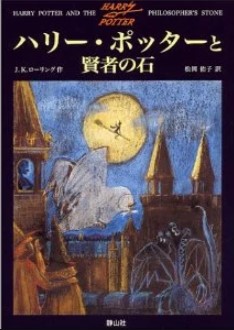Alyson Cook, Ravenclaw Hogwarts alumni

Figure 1: The UK Edition of the first Harry Potter. Image Source: http://harrypotter.wikia.com/wiki/File:Harry01english.jpg
When I think of childhood summer vacations, I often think of my mom’s lemonade, swimming at the beach of the camping ground we would always go to and staying up way past my bedtime reading all the Harry Potter books. Without even looking at my book shelf across my room, I can already picture the cover of the first book: a big red train – the Hogwarts Express –, Harry Potter himself, standing on Platform 9 ¾ looking super confused with his lightning bolt scar visible, and the title in big gold lettering across a red background proclaiming, Harry Potter and the Philosopher’s Stone.
Imagine my surprise when I was visiting a bookstore in the States a few summers ago and discovering something both strikingly familiar of past summers and surprisingly different.
Harry Potter and the Sorcerer’s Stone?
What was that! I thought. And what was this book cover? Harry Potter flying through an archway on a broomstick? Catching a Golden Snitch?
I knew I had to investigate. Flipping through the book, I confirmed that it was, in fact, J.K. Rowling’s novel that I had read so many times before, just with a different face. Somehow, I felt like I was holding something both alien and familiar.
This led me to wonder about other Harry Potter covers, and whether or not this changed how they were received or how one would approach the contents of the book. How many faces to the story of The Boy Who Lived were there?

Figure 2 The USA Edition of the first Harry Potter. Image Source: http://harrypotter.wikia.com/wiki/File:Sorcerer%27s_stone_cover.jpg
According to Pottermore, the official Harry Potter website, the Harry Potter series has been translated into 80 different languages and marketed across many different countries, meaning there are a lot of different book covers. I found five different covers from five different countries and compared them.
The cover of Harry Potter and the Philosopher’s Stone that I grew up with was the original 1997 Bloomsbury cover that was also released in the United Kingdom, where J.K. Rowling is from and where the book is set. I also found book covers that were distributed in the United States, France, Finland, and Japan. Just at first glance one can see that they are all notably different because each one illustrates different events that occur in the book. While the UK edition and the US edition depict Harry Potter similarly, with the same face shape, facial expression, hair and glasses, the subject of the cover is wildly different. The UK edition does not reveal much of the book’s actual contents. The cover depicts a boy in front of a train called the Hogwarts Express, and a sign in the background that says 9 ¾, so that when a reader picks the book up for the first time, they will have no idea what the story will be about other than that it involves a train. The US edition, however, illustrates actual elements of the storyline. The flying broomstick itself hints that the book is about magic, and Fluffy, the three-headed dog, and the unicorn illustrated in the corners are part of major plotline points.

Figure 3: French Edition of the first Harry Potter. Image Source: http://harrypotter.wikia.com/wiki/File:French_cover_Philosopher%27s.jpg

Figure 4: Japanese Edition of the first Harry Potter. Image Source: http://harrypotter.wikia.com/wiki/File:Harry_Potter_1_in_Japanese.jpg
The Finnish edition includes a different part of the novel: the life-like chess game the main three characters, Harry, Ron, and Hermione, must win in order to stop Voldemort from getting the philosopher’s stone. Differences in the Finnish edition include having Ron and Hermione on the cover, the characters being drawn completely different from both the US and the UK edition – I mean look at those noses – and the cover depicting a scene from almost the end of the novel. The French cover, on the other hand, does not include any of the previously mentioned plot points but does include all three major characters. They are dressed in dark black robes and tall witch hats, setting a more somber tone than how Harry is dressed in the US edition, who is wearing jeans, sneakers, and a striped-t-shirt. Speaking of tall hats, I found the Japanese edition the most striking: the colours are vibrant, Harry’s snowy owl Hedwig takes up the centre of the cover, and the characters wearing tall witch hats in the corner are looking up at a person riding a flying broomstick lit across the full moon.

Figure 5: Finnish Edition of the first Harry Potter. Image Source: http://harrypotter.wikia.com/wiki/File:Finnish_Book_1_cover.jpg
All five covers are the face of the same novel, the same characters, and the same story. But each has a wildly different portrayal of the story itself, and each would influence readers into perceiving the story in a different way: UK readers would be waiting for the train, US readers would be on the lookout for unicorns, French readers would envision the Hogwarts robes and hats as stereotypically witchy, Finnish readers would be thinking of crazy big noses and chess, and Japanese readers would come to the novel with images of owls and spooky nights.

Figure 6: The new UK edition of the first Harry Potter. Image Source: http://harrypotter.wikia.com/wiki/File:Philosoper%27s_Stone_New_UK_Cover.jpg
Judging a book by its cover is something readers will automatically do when picking up a book to gauge whether it’s worth reading or not. But different versions of book covers will change how readers will approach the same story, which is something that should be taken into consideration when thinking about the publication of books. Harry Potter books are still being published, and there are new book covers to go along with them. My little cousin just began reading the series, and when I asked him, he told me that he thought Hagrid looked “a little scary” on the cover. Hagrid? Scary? Never, I thought, but I actually have to agree with him. He does look a little scary. I still read the Harry Potter novels in my free time, though I’ve changed my mom’s lemonade for (Butter) beer, but I often wonder if how I pictured characters, buildings, and events in my head would have been different if the first copy I owned had had a different face.

Figure 7: A display of Harry Potter books from the International British Library Exhibition Harry Potter: A History of Magic. Image Source: https://www.pottermore.com/news/500-million-harry-potter-books-have-now-been-sold-worldwide
Works Cited and Consulted
Ostrowski, Cole, 2nd Year Hogwarts Student, Gryffindor, little cousin.
The Pottermore News Team. “500 million Harry Potter books have now been sold worldwide”, Pottermore. 2018. Accessed January 21, 2019. https://www.pottermore.com/news/500-million-harry-potter-books-have-now-been-sold-worldwide